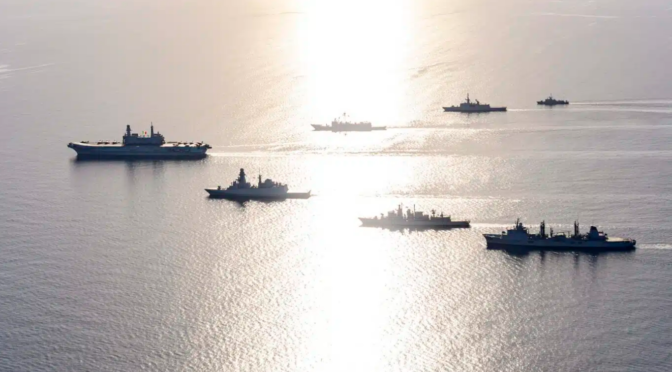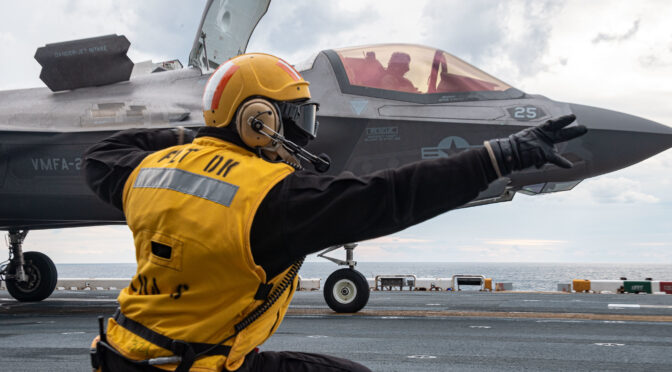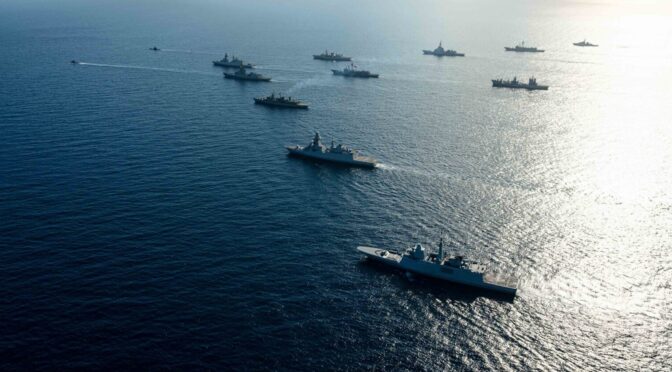By David Scott
The Italian Navy deployed in force to the Indo-Pacific in the second half of 2024, sending a Carrier Strike Group comprised of the aircraft carrier ITS Cavour and frigate ITS Alpino, along with the independent deployments of ITS Raimondo Montecuccoli and ITS Amerigo Vespucci. These deployments, which represented various firsts for Italy, underpin, underscore, and operationalize the Meloni administration’s pursuit of new strategic horizons far beyond the Mediterranean Sea.
Strategic Context
Italian maritime doctrine is increasingly looking beyond its traditional focus on the Mediterranean. Admiral Giorgi’s signaled this shift in 2017 with the “Mediterraneo allargato,” echoed by Talbot and Fruganti’s “wider” and Zampieri and Ghermandi’s “enlarged,” Mediterranean, a maritime space reaching down the Red Sea into the Indian Ocean. Bartoli wrote of an “Indo-Mediterranean;” Droin and Rossi framed the conversation in the strategic terms of a “Mediterranean-Indo-Pacific continuum.”
The administration of Giorgia Meloni, in power since October 2022, has operationalized such an Italian outreach to the Indo-Pacific. Prime Minister Meloni was clear on this during her summit trip to India in March 2023:
“Ours is a strategic choice because, [….] when we talk about the ‘wider Mediterranean’ we must consider that it extends all the way to here [India]. The Mediterranean Sea and the Indo-Pacific are interconnected, and we want to strengthen that interconnection more and more.”
Particularly significant cooperation across the Indo-Pacific is evident for Italy with the U.S., India, Japan, and Australia. Meloni’s own state visits to India and Japan during 2023 have been consequential. The Meloni administration’s withdrawal from China’s Belt and Road (BRI) initiative in March 2024 and rapid pivot to the India-Mediterranean Economic Corridor (IMEC) initiative in September 2024 was a telling reorientation.
Italy has especially focused on India as it expands operations in the Indo-Pacific. At the end of Meloni’s visit in March 2023, the India-Italy Joint Statement emphasized “the importance of a free, open and rules-based Indo-Pacific,” “freedom of navigation,” and “collaboration in ensuring maritime security.” This statement was partly aimed at piracy and jihadist disruption in the Indian Ocean, but also at China. Italy agreed to take joint lead in the Science, Technology, and Academic Cooperation pillar of the Indo-Pacific Oceans Initiative (IPOI) launched by India. At Meloni’s meeting with Narendra Modi in June 2024, the Indian side specifically noted and welcomed the scheduled forthcoming visits of the Cavour aircraft carrier and the Vespucci to India.
With regard to Japan, Meloni met Japan’s then-leader Fumio Kishida several times during 2023. Meloni’s first meeting with Kishida in January 2023 recorded growing “cooperation in the Indo-Pacific” in which it was decided to elevate bilateral relations to the Strategic Partnership status, and to launch a bilateral Foreign Affairs-Defense consultation mechanism. Her summit meeting in May 2023 recorded they would “continue to coordinate closely in addressing issues relating to China.”
Italy also reached out to Australia during 2023. In January 2023, Maria Tripodi, the Undersecretary of State for Foreign Affairs and International Cooperation, told her Australian counterpart that Italy looked on Australia as “a partner and key player in the Indo-Pacific region, one of the main protectors of the rule of law, freedom of navigation [and sustainable infrastructural development.” Italy’s other Undersecretary of State, Giogio Sill’s “elaborate” mission to Australia in November 2023, focused on the “geostrategic balance in the Indo-Pacific.”
Last but not least, in a similar China-concerned vein, the Italian Ministry of Foreign Affairs Secretary General Riccardo Guarilga co-chaired the United States-Italy Consultation on the Indo-Pacific meeting on May 21, 2024, in Washington.
Given that the Indo-Pacific is primarily a maritime area, linked by the disputed South China Seas, it is no surprise that Italy’s involvement has been heavily maritime-focused, and practically implemented in its naval deployments in 2023 and in greater strength in 2024.
2023 Naval Deployment: Francesco Morosini
An immediate manifestation of the Meloni administration’s embrace of the Indo-Pacific was the dispatch of the Francesco Morosini across the Indo-Pacific during 2023. The Morosini was a new Paolo Thaon di Revel-class multipurpose PPA Offshore Patrol Vessel. In reality, the Morosini is more akin to a frigate – armed as it is with a lightweight torpedo system and three helicopters.
This was a five-month deployment from May to September 2023. The Morisini’s deployment beyond the Suez Canal took her down the Red Sea, across the Indian Ocean, and the South China Sea and East China Sea to Japan. Enrico Credendino, the Italian Navy Chief of Staff characterized the area as one in which “our Navy has been missing for several years, a world that we know little about, but in which there is a strong strategic, military, diplomatic and political interest.”
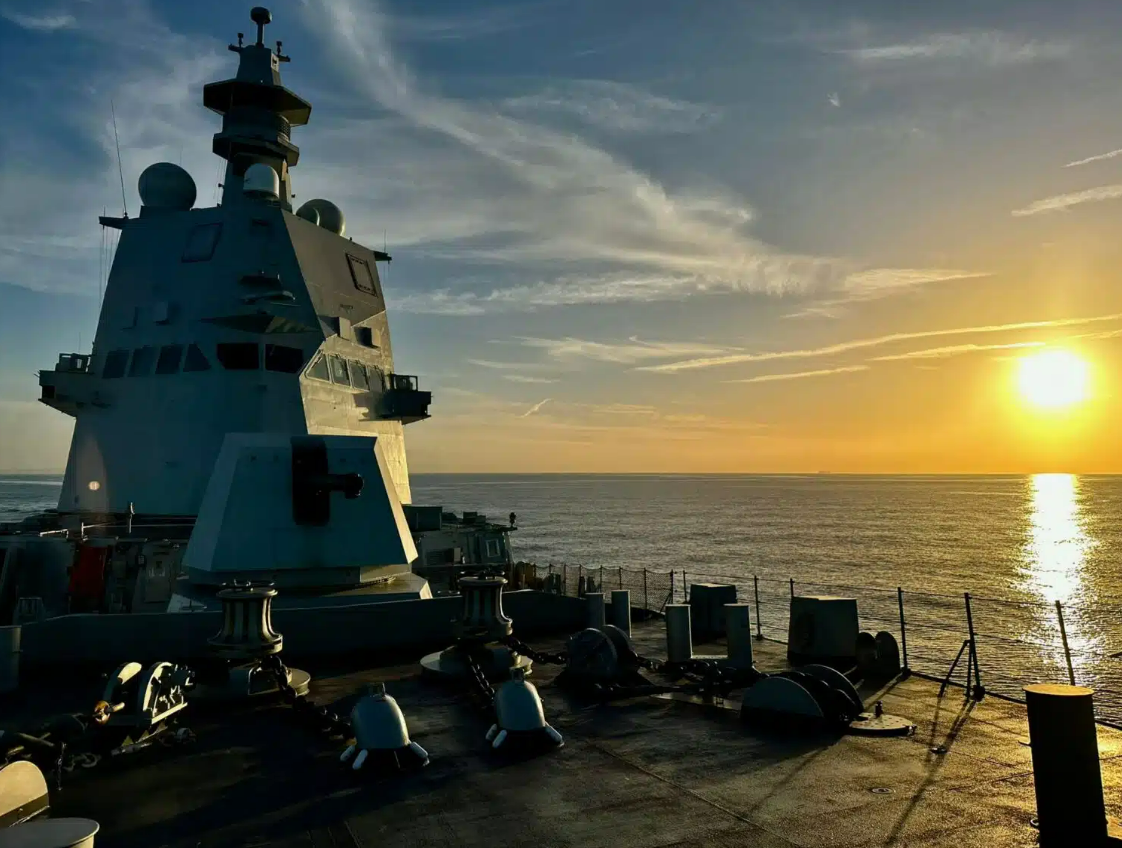
No contacts were made with China throughout its mission, instead a range of China-concerned countries were visited. China’s Global Times criticized the tour as “a mission aimed at developing synergies and training experiences with the Quad.”
The Morisini first called in Djibouti, before steaming in the Gulf of Aden and participating in the anti-piracy Operation Atalanta (operating since 2008), followed by the Straits of Hormuz and Persian Gulf for Operation Agenor. However, what was new was that the Morisini then steamed eastwards across the India Ocean.
In Southeast Asia, the Morisini participated in Singapore’s leading defense exhibition IMDEX 2023 from May 3–5 and the Langkawi International Maritime and Aerospace Exhibition (LIMA) in Malaysia from May 23–27. It also joined the multilateral Komodo 2023 exercise hosted by the Indonesian Navy. The Morisini’s visit was also the lever for Italian sales of such PPA multipurpose patrol vessels to Indonesia, “amid China fears” shared by both countries. The Italian Embassy in Hanoi welcomed the Morosini’s port call in May 2023 with a clear and unambiguous message on the Morisini’s mission:
“The Morosini visit takes place in the framework of a five-month naval campaign in the Indo-Pacific region [….] to promote naval diplomacy and maritime capacity building alongside with freedom of navigation and respect for the international law of the sea.”
The issue of freedom of navigation and respect for international law of the sea was aimed at China in the South China Sea. Crossing the South China Sea, in itself a tacit freedom of navigation traverse, the Morisini then exercised with the Japanese Navy (JS Hamana) in the East China Sea. Busan in South Korea and Yokosuka were the furthest limits of Morisini’s deployment.
Returning from Japan, the Morisini visited Manila, Jakarta, Chittagong, Mumbai and Karachi. During the stay at Manila, Rear Admiral Fabio Gregori, commander of the Italian Navy Fleet, toured the ship, expressing Rome’s interest in strengthening naval cooperation with Manila in the Indo-Pacific region in general and the South China Sea in particular. A PASSEX was carried out with the Philippine Navy.
At Mumbai, the Morisini’s commanding officer Giovanni Monno addressed the Italy-India Maritime Security Seminar organized by the Italian Embassy and the National Maritime Foundation. As a panelist, Rear Admiral Giuseppe Schiwardi, Director of the Strategic Studies Centre at Italy’s Naval Staff College, argued in his paper Connecting Italy’s Mediterranean and India’s Ocean:
“Italy and India have national and common interests to protect, and Italy is a reliable partner. The Indian Ocean is contiguous and inescapably linked to Italy’s “Wider Mediterranean” [Mediterraneo Allargato].
The momentum of this one-ship 2023 deployment was maintained and deepened with the more powerful four-ship deployments during 2024, moving naval diplomacy and exercising to the fore.
2024 Naval Deployments
The noticeable feature in 2024 has been the multiple deployments by Italy: not only soft power in the shape of the Amerigo Vespucci but also hard power in the shape of the Raimondo Montecuccoli, and above all, the Carrier Strike Group (CSG) made up of the Cavour aircraft carrier and supporting Alpino frigate. These three components at various times crossed each other’s paths. The Vespucci and the Montecuccoli sailed together from Los Angeles to Honolulu, while the Montecuccoli joined the CSG at various points in the Western Pacific, South China Sea, and Gulf of Aden. In contrast to the deployment of the Morisini in 2023, both the Montecuccoli and the CSG participated in a range of high-end exercises with allies and partners having similar concerns about China. Italian defense technology was also on show as the Italian Defense Industries Forum put on three exhibitions, fielded by Vice Admiral Guiseppe Abbamonte Director of the Italian Naval Armaments Directorate; at Yokosuka on board the Cavour aircraft carrier, at Manila on board the Alpino, and at Jakarta on board the Montecuccoli.
Amerigo Vespucci
The Vespucci is the Italian navy’s oldest vessel, built in 1931 as a graceful tall ship, a full-rigged three-masted sailing ship with auxiliary diesel engine propulsion. It transited the Beagle Channel and Cape Horn in April 2024, and the Red Sea in January 2025, the first time in 20 years that the Vespucci, “the world’s most beautiful ship” (Gurioli), had left Italian waters. Its itinerary took it east to west across the Indo-Pacific.
Port calls were arranged for Valparaiso (April 28–May 2), Callao (May 12–15), Guayaquil (May 21–24), Balboa (May 31–June 2), Acapulco (June 15–18), Puerto Vallarta (June 19–23 ), Los Angeles (July 3–8), Honolulu (July 24–28), Yokosuka (August 22), Tokyo (August 25–30), Manila (September 14–18), Darwin (October 4–7), Jakarta (October 20–24), Singapore (October 24–28), Phuket (November 6–10), Mumbai (November 24–28), Karachi (December 3–6), and Oman (January 8–15).
Such port calls were supplemented by Italian Villages set up (the one in Los Angeles by the Defense Minister), and tours and meetings held on board. On board the Vespucci, the Italian ambassador to Japan Gianluigi Benedetti explained its visit as:
“A sign that has a wider value, multilateral if you will, a global strategic value. Italy’s confirmation to want to contribute to peace and stability in the world, ensuring the coordination in cooperation with other partners and countries of various areas, maritime safety and security and freedom of navigation, also in the Indo-Pacific.”
Italy’s Navy Chief of Staff Enrico Credendino attended the stop in Singapore, as well as Undersecretary of Defense Matteo Perego di Cremnago. Credendino reappeared for the stop in Oman, commenting in discussions with Omani counterparts that “it is essential to keep the maritime lines of communication open” and noting the “great attention for the arrival of the Amerigo Vespucci ship.”
Raimondo Montecuccoli
Officially termed an Operational Projection Capaign (OPC) by the Marina Militare, the Montecuccoli, the third Thaon di Revel patrol boat, and the first with anti-air warfare capabilities (PPA Light Plus configuration), entered the Pacific through the Panama Canal on May 26. Stopping at Manzanillo from June 5–8 and San Diego from June 12–16, like the Vespucci, the Montecuccoli then took an east-west direction across the Indo-Pacific. Friendly port calls were interspersed with hard power military exercising with China-concerned allies and partners, with the Italian Carrier Strike Group (CSG) joined at various points.
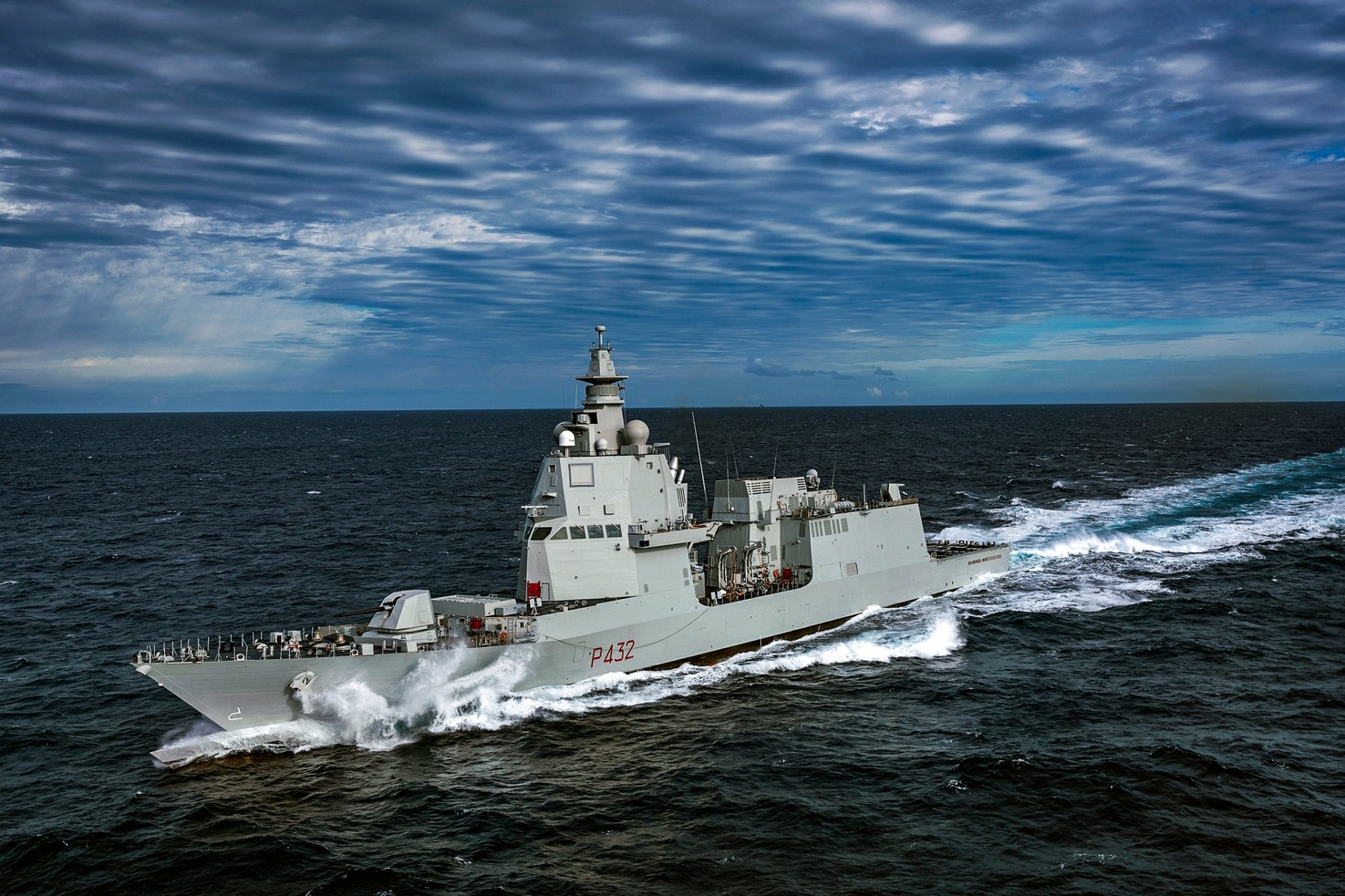
In such a hard power vein, from June 27 June to August 1, the Montecuccoli participated in the first at-sea phase of Rim of the Pacific (RIMPAC) exercise; before joining in Pacific Dragon ballistic missile defense exercise from July 29 to August 13, in the waters around the Hawaiian Islands. This was alongside other naval units from Australia (HMAS Sydney), Japan (JS Haguro), South Korea (ROKS Yulgok Yi I) the Netherlands (HNLMS Tromp), and the U.S. (USS Carl M. Levin, USS Kidd and USS Shiloh). Notably, Italy’s participation in each major exercise was a first.
The Montecuccoli next went to Japan. From August 27–29 it participated, alongside the Italian CSG, in the Noble Raven exercise organized by the Japanese Navy. Its arrival at Okinawa on August 31 drew the comments from the Italian consul Marco Prencipe:
“The presence today of the Offshore Patrol Vessel Montecuccoli is a concrete manifestation of Italy’s ability to project – even in this region that is so strategic for the world’s geopolitical and geo-economic balances – to invest in sectors with very high technological content such as the naval industry, and is added to that of the sailing ship Vespucci [Tokyo], the ship Cavour, and the Alpino [at Yokosuka, as] an articulate presence of the Italian Navy.”
In another first for Italy, the Montecuccoli conducted patrols monitoring sanctions against North Korea in the waters around Japan from late August to early September 2024, and paid a three-day port call in South Korea at Busan from September 4–6.
Next the Montecuccoli joined the Italian CSG in four days exercising from September 9–12 with the U.S. Navy (USS Russell) and Australian Air Force (Poseidon Maritime Patrol Aircraft) in the South China Sea. Friendly port calls were then made at Jakarta (14-17 September, with the CSG), Laem Chabang (23-27 September), Port Klang (2-4 October) and Colombo (10-13 October).
By October 18 the Montecuccoli had rejoined the Italian CSG to conduct exercises with the US Abraham Lincoln CSG in the Gulf of Aden, echoing their similar exercising together in August. Still with the Italian CSG, it returned up the Red Sea in late-October
Carrier Strike Group
The significance of this deployment was its strength, Italy’s Carrier Strike Group (CSG), made up by the aircraft carrier Cavour and the Alpino frigate. The Cavour aircraft carrier, with 30,000 tons full load displacement, operates advanced F-35B warplanes, enabling interoperability with the Japanese and U.S. navies. The CSG’s itinerary was the Red Sea-Salalah-Singapore-Darwin & Coonawarra-Guam-Yakosuka-Manila-Jakarta-Singapore-Goa-Karachi-Red Sea. China featured nowhere as a port of call. Its exercising was pointed in bilateral, trilateral and quadrilateral formats.
Italian exercising with the U.S. across the Indo-Pacific was extensive. Having exercised on June 7 with the Dwight D. Eisenhower CSG, the Italian CSG (accompanied by FS Forbin) entered the Indo-Pacific and further bilateral exercising with the U.S.:
- June 28: South China Sea, exercise with the USS Mobile CSG
- August 9: Philippine Sea, exercise with the Abraham Lincoln CSG
- September 12: South China Sea, exercise with USS Russell
- October 18: Gulf of Aden, exercise with the Abraham Lincoln CSG
The fact that there were three separate aircraft carrier (Multi-Large Deck Event, MLDE) exercises carried out between the Italian and U.S. CSGs was a powerful indicator. The two Italy-U.S. bilateral exercises in the South China Sea were a very direct signal to China.
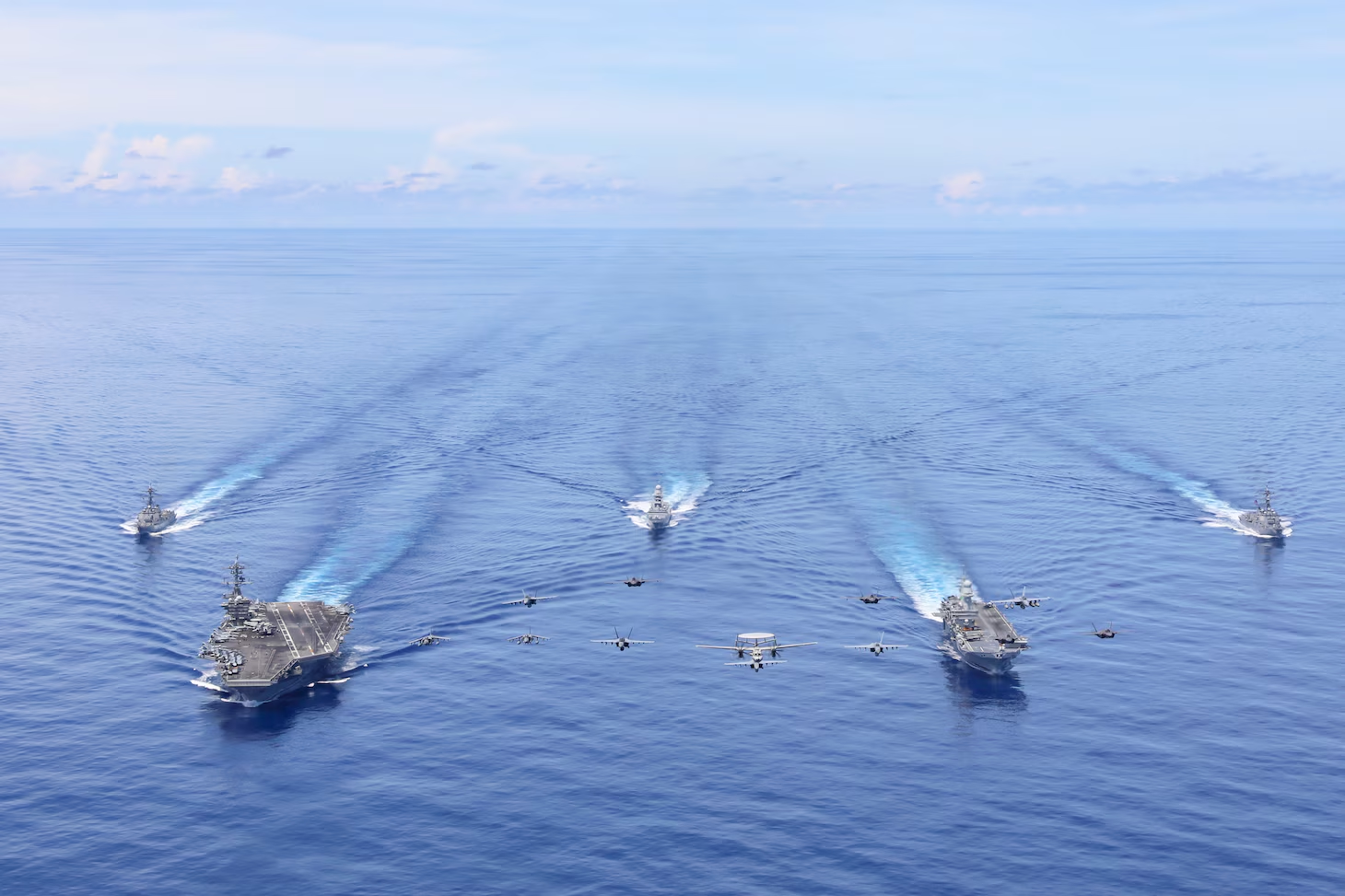
Italian bilateral carrier exercising with Japan was also on show. Combined F-35B operations and landings between their respective aircraft carriers were carried out at Yokosuka naval base from August 22–27.
CSG exercises were also carried out with India. In the waters off Goa, the Cavour and Alpino exercised with India’s own CSG (aircraft carrier INS Vikramaditya and the destroyer INS Visakhapatnam) from 1-6 October. The exercising included air combat missions and coordinated weapons firings.
Wider China-concerned formats were also pursued by the Italian CSG. July 2024 witnessed another first time event, Italian participation in the extended Pitch Black aircraft exercises in Australia, courtesy of the Cavour’s F-35Bs. This was alongside aircraft and personnel from Australia, Brunei, Canada, Fiji, France, Germany, India, Indonesia, Japan, Malaysia, New Zealand, Papua New Guinea, South Korea, Singapore, Spain, Thailand, the U.K., and the U.S.. China was not invited. The Italian Admiralty judged that Black Pitch:
“Highlighted the relevance of the presence of the Italian Defense Force in the Indo-Pacific, crucial in the global geopolitical context, and the importance of complex and challenging exercises, tests of logistical projection capability at great distance and interaction with Allied Countries.”
The Italian CSG and the Montecuccoli was also involved in the Noble Raven exercise from August 27–29, organized by the Japanese Navy in waters off Japan, and Italy’s first ever involvement. This was something of a naval “formation foxtrot” with Japan’s helicopter carrier JS Izumo, the destroyer JS Onami, submarine and P-1 maritime patrol aircraft, France’s frigate Bretagne, Germany’s frigate FGS Baden-Württemberg and fleet oiler FGS Berlin and Australia’s destroyer HMAS Sydney. The embarked Japanese personnel also stayed on the Cavour until Manila, allowing them to further observe F-35B flight operations on board the Italian carrier.
The Cavour CSG, still joined by the French Frigate Bretagne, and again joined by the Montecuccoli, practiced four days of fixed-wing air defense and anti-submarine exercises in the South China Sea from 8-11 September with the U.S. Navy (USS Russell guided-missile destroyer) and Australian Air Force (Poseidon Maritime Patrol Aircraft).
Impact
In the wake of Black Pitch and the varied exercises in Japan, Enrico Credendino the Chief of the Italian Navy was pleased to announce on August 28 at Yokosuka, on board Italy’s aircraft carrier, that Initial Operational Capacity (IOC) for its F-35B component had been achieved:
With the IOC (achievement), the maritime component of Italy’s Defense takes a significant step forward in expressing the ability to project forces from the sea even in operational theatres far from the usual gravitational basins, for extended periods of time, pursuing complete interoperability and interchangeability in joint operations with allies and partners: one of the main objectives of the Carrier Strike Group campaign in the Indo-Pacific.
The impact of the Italian deployments in 2024 is three-fold. Firstly, Italy’s profile is undeniably higher throughout the Indo-Pacific, as a useful technological partner for smaller-medium size Asian states like Indonesia, and a useful security partner for India and Japan. Secondly, Italy has worked alongside the U.S. across the Indo-Pacific.
In addition, an implicit message has been sent to China. Beijing may indeed have refrained from overt official criticism of Italian naval deployments in 2024, but this was probably calculated public diplomacy for Meloni’s visit to China in July. Nevertheless, by September the Chinese state media (Global Times) had labeled the presence of the Cavour in Japan as part of a NATO “threat” to China. A National Interest headline in October “China is freaked: Italy’s flagship aircraft carrier is training with India” was blunt but accurate. A message had indeed been delivered by Rome. An Indo-Pacific maritime presence has been established.
Indeed, even as the Amerigo Vespucci docked at Jeddah on 25 January, to be welcomed by Prime Minister Meloni, Italy’s Indo-Pacifico 2025 was already underway with the dispatch of the frigate ITS Antonia Marceglia which left Italy on January 20 for a six month “Projection Campaign.” Admiral Aurelio de Carolis “emphasized” that the missions aligned with EU and NATO “strategies to counterbalance China.” On its way across the Indian Ocean to Japan, 12 countries are being visited by the Antonia Marceglia, with China absent from the list. The vessel participated in the Indonesian-hosted Komodo 2025 exercises from 15-22 February, and was also set to interact with French and, of significance for the Trump administration, U.S. aircraft carrier groups in the region.
Dr. David Scott is an associate member of the Corbett Centre for Maritime Policy Studies. A prolific writer on Indo-Pacific maritime geopolitics, he can be contacted at davidscott366@outlook.com
Featured Image: The IT CSG with Cavour carrier as flagship of the EUMARFOR surface force. (EUROMARFOR photo)

